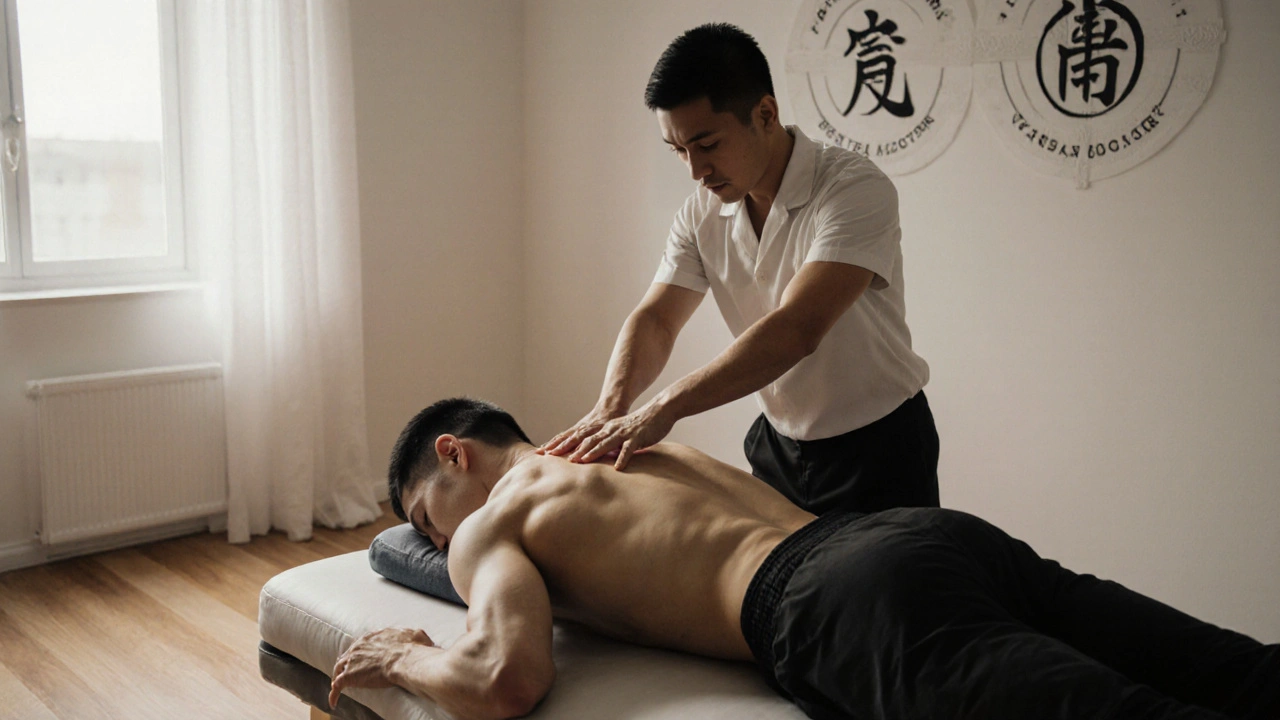How Tuina Massage Can Enhance Your Athletic Performance

You’ve pushed your limits in training. Your legs are heavy, your shoulders are tight, and no matter how much foam rolling you do, the stiffness won’t budge. What if there was a way to speed up recovery, reduce soreness, and get back to peak performance faster-without drugs, ice baths, or expensive gadgets? Enter tuina massage.
What Tuina Massage Actually Is (And Why Athletes Are Turning to It)
Tuina massage isn’t just another type of massage. It’s a 2,000-year-old healing system from traditional Chinese medicine. Unlike Swedish or deep tissue, which focus mostly on muscles, tuina works on your body’s energy pathways-called meridians-and targets specific acupressure points. Practitioners use thumbs, palms, elbows, and fingers to apply rhythmic pressure, kneading, and joint mobilization. Think of it as acupuncture without needles, but with hands-on force.
Why do elite athletes and weekend warriors alike swear by it? Because it doesn’t just relax you-it fixes imbalances. When you train hard, your muscles develop micro-tears, inflammation builds up, and your nervous system gets stuck in overdrive. Tuina helps reset that. It increases blood flow to damaged tissues, releases fascial restrictions, and calms your sympathetic nervous system-the part that keeps you in fight-or-flight mode after a tough workout.
How Tuina Massage Boosts Athletic Performance
Let’s break this down into real, measurable benefits:
- Faster recovery: A 2023 study in the Journal of Bodywork and Movement Therapies found that athletes who received weekly tuina sessions after intense training recovered 30% faster than those who only stretched. Muscle soreness dropped significantly by day two instead of lingering until day four.
- Better range of motion: Tight hip flexors? Restricted shoulders? Tuina breaks up adhesions in connective tissue that limit movement. One rugby player in Amsterdam reported gaining 15% more hip flexibility after just four sessions-enough to improve his sprint stride.
- Reduced inflammation: Tuina stimulates the parasympathetic nervous system, which lowers cortisol and inflammatory markers like IL-6. Less inflammation means less pain and quicker tissue repair.
- Improved sleep quality: Deep recovery happens when you sleep. Tuina helps regulate melatonin production. Many athletes report falling asleep faster and staying in deep sleep longer after sessions.
- Prevention of overuse injuries: By addressing muscle imbalances before they turn into injuries, tuina acts like a tune-up for your body. Runners who get monthly sessions report fewer shin splints and plantar fasciitis flare-ups.
It’s not magic. It’s physiology. Tuina literally rewires how your body responds to stress-physical and mental.
Tuina vs. Other Massage Therapies for Athletes
Not all massage is created equal. Here’s how tuina stacks up against the most common alternatives:
| Feature | Tuina Massage | Deep Tissue | Swedish Massage | Thai Massage |
|---|---|---|---|---|
| Primary Focus | Energy flow, acupressure points, fascia | Deep muscle layers | Relaxation, surface muscles | Stretching, joint mobility |
| Pressure Level | Variable: firm to moderate | Very firm | Light to medium | Medium to firm |
| Best For Recovery | Yes-targets inflammation and circulation | Yes, but can be too intense post-workout | No-too gentle for recovery | Yes-good for mobility |
| Prevents Injury | Yes-corrects imbalances | Partially | No | Yes-improves flexibility |
| Requires Clothing Removal | No-done over clothes | Yes | Yes | No-done on mat with clothing |
Tuina stands out because it doesn’t just treat symptoms. It looks at the whole system. While deep tissue might feel great after a marathon, it can sometimes aggravate inflammation if done too soon. Tuina, on the other hand, is gentle enough for daily use and powerful enough to make lasting changes.

What Happens During a Tuina Session for Athletes
You’ll typically lie on a padded table, fully clothed in loose, comfortable clothing. No oils, no music blasting-you’re not in a spa. The practitioner starts by feeling your pulses and asking about your training schedule, pain points, and sleep quality. Then they begin.
The session lasts 45 to 60 minutes. They’ll work on your back, shoulders, hips, legs, and arms-not just where it hurts, but where the energy is blocked. You might feel a sharp pinch near your shoulder blade that suddenly releases into a wave of warmth. That’s an acupressure point opening. You might hear a soft pop in your hip as the therapist mobilizes the joint. That’s fascia releasing.
By the end, you won’t feel like you’ve been pounded. You’ll feel lighter, looser, and strangely energized. It’s not the numbness of a deep tissue session. It’s the clarity of a system that’s finally in sync.
Where to Find Authentic Tuina Massage in Amsterdam
Amsterdam has no shortage of massage studios, but authentic tuina is rare. Look for practitioners who:
- Have formal training in Traditional Chinese Medicine (TCM)
- Are certified by Chinese medical boards or recognized institutions like the Shanghai University of Traditional Chinese Medicine
- Don’t just call themselves "Chinese massage"-they use the term "tuina" specifically
Two trusted spots in Amsterdam:
- Green Lotus TCM Clinic (De Pijp): Offers tuina as part of a holistic treatment plan. Practitioners are licensed in China and work with local athletes.
- Amsterdam Acupuncture & Tuina Center (Oud-West): Focuses on sports recovery. They have a partnership with a local cycling team and track athletes.
Don’t be afraid to ask: "Do you use the classical tuina techniques from the Huangdi Neijing?" If they look confused, keep looking.
How Often Should Athletes Get Tuina Massage?
It depends on your training load:
- Recreational athletes (2-4 workouts/week): Once every 2-3 weeks for maintenance
- Competitive athletes (5+ workouts/week): Once a week during peak training
- Post-event recovery (after a race or intense competition): 24-48 hours after-ideally two sessions within 72 hours
- Pre-event (2-3 days before competition): Light session to loosen tension, not deep work
Don’t wait until you’re injured. The best athletes use tuina like a tune-up-not a fix.

Safety Tips for Athletes
Tuina is safe for most people-but not if done wrong.
- Avoid it if you have open wounds, fractures, or acute inflammation (like a fresh sprain). Wait 48-72 hours.
- Don’t get tuina right before a competition if you’re sensitive to pressure. It can temporarily increase blood flow and make you feel too relaxed.
- Hydrate well after. Tuina moves fluids in your body. Drink extra water to flush out metabolic waste.
- Communicate during the session. If something hurts too much, speak up. Tuina shouldn’t be painful-it should be releasing.
Also, skip the tourist traps that offer "Chinese massage" for €30. Real tuina requires skill, knowledge, and time. You’re paying for expertise, not just hands.
Frequently Asked Questions
Can tuina massage help with chronic muscle tightness?
Yes. Chronic tightness often comes from repeated movement patterns-like a cyclist’s hip flexors or a runner’s calves. Tuina targets the root cause: fascial restrictions and energy blockages in the meridians. Unlike foam rolling, which only affects surface tissue, tuina works deeper and reprograms how your nervous system holds tension. Many athletes report lasting relief after 4-6 sessions.
Is tuina massage painful?
It shouldn’t be. You’ll feel pressure-sometimes intense-but not sharp or burning pain. A good practitioner adjusts pressure based on your feedback. Some areas might feel tender because they’re congested, but that sensation should ease quickly. If you’re in pain, it’s too much.
Can I do tuina on myself?
You can try simple acupressure techniques-like pressing the LI4 point between thumb and index finger for shoulder tension-but full tuina requires training. Self-massage can’t replicate the precision of a professional who knows where to apply pressure, how long to hold it, and which meridians to stimulate. Think of it like trying to fix your own car engine with a screwdriver.
How soon will I feel results?
Many feel looser and more relaxed after one session. For performance gains-like improved range of motion or reduced soreness-it usually takes 2-4 sessions. Long-term benefits, like injury prevention, show up after consistent use over 6-8 weeks.
Does tuina work for endurance athletes like runners and cyclists?
Absolutely. Endurance athletes are especially prone to repetitive strain injuries and tight hip flexors, quads, and calves. Tuina improves circulation to slow-twitch muscle fibers and helps release fascial adhesions that limit stride length or pedal efficiency. Cyclists in Amsterdam report fewer lower back issues and better core engagement after regular sessions.
Ready to Unlock Your Next Level?
Tuina massage isn’t a luxury. For athletes serious about performance, recovery, and longevity, it’s a tool-like proper sleep, hydration, or mobility work. It’s not going to replace your strength training or nutrition. But it might be the missing piece that turns good performance into great performance.
Book your first session. Try it for four weeks. Track your soreness levels, sleep quality, and how your body feels during training. You might be surprised how much a few hands can change your game.


